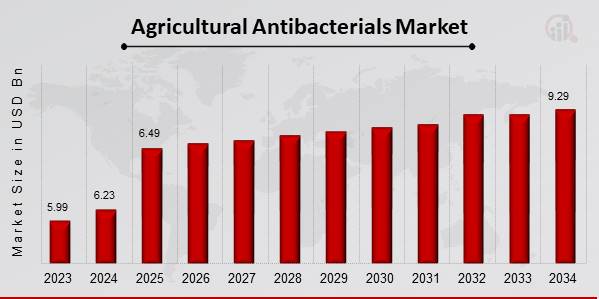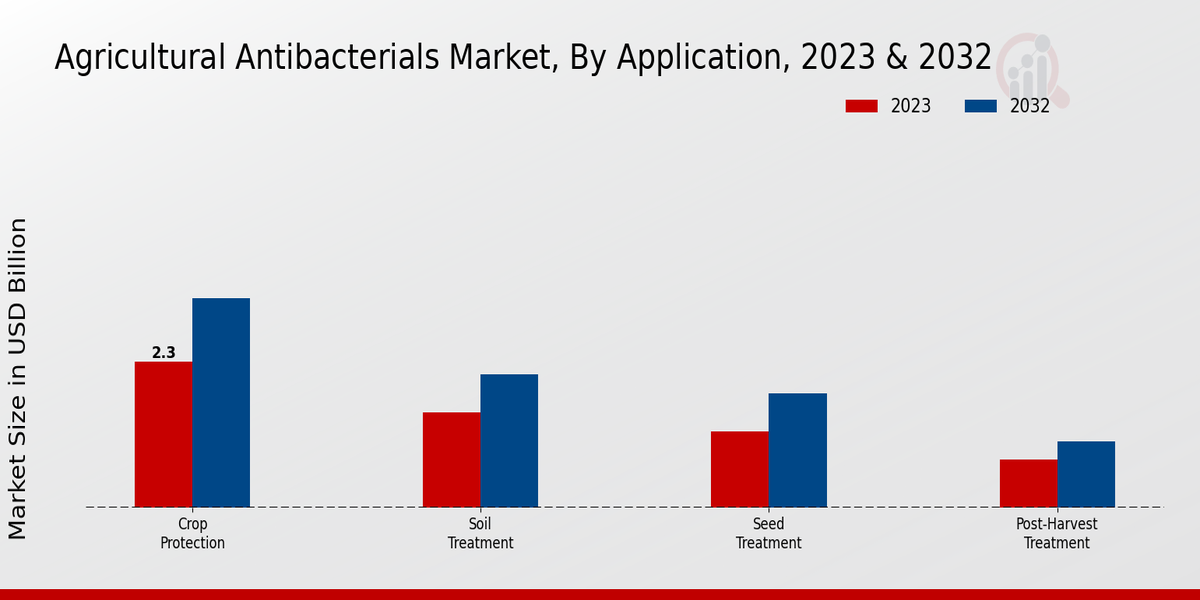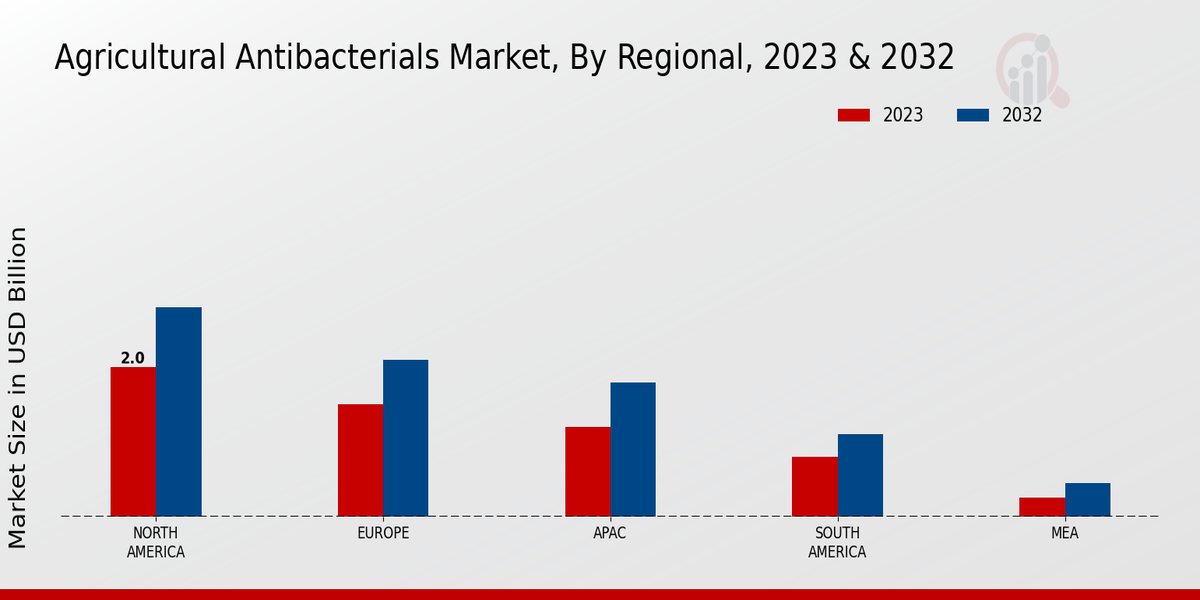Global Agricultural Antibacterials Market Overview
Agricultural Antibacterials Market Size was estimated at 6.23 (USD Billion) in 2024. The Agricultural Antibacterials Market Industry is expected to grow from 6.49 (USD Billion) in 2025 to 9.29 (USD Billion) by 2034. The Agricultural Antibacterials Market CAGR (growth rate) is expected to be around 4.1% during the forecast period (2025 - 2034).

Source Primary Research, Secondary Research, MRFR Database and Analyst Review
Key Agricultural Antibacterials Market Trends Highlighted
The Agricultural Antibacterials Market is propelled by the increasing demand for the safety of food products as well as the growing incidence of bacterial infections in both crop and livestock farming. It is important to note that farmers and agricultural producers have come to realize the need to uphold health standards, ensuring that the yield produced is of great quality. It is this awareness that enhances the usage of antibacterials as disease prevention and control measures. A growing number of farmers are also advocating for sustainable agricultural practices, which has stimulated research into the development of efficient and environmentally friendly anti-bacterial products. The opportunities in the agricultural gap are also increasing as the sector aims to enhance productivity whilst reducing the amount of chemicals applied to crops.
As a result, biopesticides and other natural antipesticides and antibacterial agents are being used as alternatives that address environmental concerns. These newer technologies include precision farming, biotechnology, machinery, and innovative genetic engineering. All narrow down to how agriculture can be modernized to meet specific needs. There is a market for emerging market areas that look like they are going to introduce a lot of agriculture so marketing new products should not be an issue. The most recent trends have indicated that there is a move towards compliance with the set regulations and onset of quality assurance processes towards agriculture practices. Organic products are also taking the market which will force farmers to use natural antibacterials to stay in competition.
The focus of research and development is shifting more towards understanding the resistance of bacteria as well as utilizing probiotics as eco-friendly alternatives to conventional antimicrobials. Furthermore, it is becoming a normal occurrence for agronomists, researchers, and biotechnologists to work together in producing new and enhanced antibacterial formulations. These innovations also demonstrate the sector’s flexibility and dedication to furthering its potential for sustainable development in the fight against food safety and agricultural health issues.
Agricultural Antibacterials Market Drivers
Increasing Demand for Food Safety
The Agricultural Antibacterials Market Industry is experiencing significant growth primarily due to the rising demand for food safety and quality assurance. As consumers become more health-conscious, there is an increased focus on ensuring that the food supply is free from harmful bacteria. Agricultural antibacterials play a crucial role in preventing infections in livestock and crops, thus enhancing food safety protocols. With the population projected to increase steadily, the demand for safe and sustainable food sources becomes more critical.
Agricultural antibacterials help to maintain the quality of produce and livestock, ultimately ensuring that consumers receive high-quality products that adhere to safety standards. This growing awareness and demand for food safety measures among consumers, along with regulatory pressures for food manufacturers and producers to enhance safety protocols, are propelling the growth of the agricultural antibacterials market. Additionally, as agricultural practices evolve and the challenges related to bacterial infections in crops and livestock become more apparent, the reliance on effective agricultural antibacterials will continue to rise.
This combination of consumer demand for quality food and the need for agricultural sustainability underlines the importance of antibacterials in ensuring safe food products, thus driving market growth in this segment.
Government Regulations and Support
In recent years, governments around the globe have implemented stringent regulations aimed at ensuring antibiotic usage is safe and effective in agriculture. These regulations often encourage the responsible use of agricultural antibacterials to minimize the risk of antibiotic resistance while promoting food safety in the agricultural sector. Government initiatives, grants, and subsidies aimed at adopting newer technologies and practices in farming can also lead to increased investments in agricultural antibacterials.
This support is crucial for the development of innovative products and practices essential for protecting crops and livestock, thus fostering growth in the Agricultural Antibacterials Market Industry.
Technological Advancements in Agricultural Practices
The Agricultural Antibacterials Market Industry is benefiting from technological advancements that improve the effectiveness and application of antibacterials in agriculture. Innovations such as precision agriculture, biopesticides, and improved formulation techniques enhance the efficacy of agricultural antibacterials. These advancements allow for targeted application, reducing the overall usage while increasing effectiveness against pathogens.
As technology continues to evolve in the agricultural sector, it is anticipated that the uptake of efficient and sustainable agricultural antibacterials will rise, further driving market growth.
Agricultural Antibacterials Market Segment Insights
Agricultural Antibacterials Market Application Insights
The Agricultural Antibacterials Market is characterized by its diverse applications, which play a crucial role in enhancing agricultural productivity and protecting crops from harmful bacterial infections. In 2023, the value of the overall market, focusing on application segments, is quantified at 5.76 USD Billion, with a notable growth trajectory expected in the coming years. Among the various applications, Crop Protection holds a majority share, valued at 2.3 USD Billion in 2023 and projected to reach 3.3 USD Billion by 2032. This dominance is primarily due to increasing concerns over crop losses caused by bacteria and the growing need for efficient pest and disease management.
Soil Treatment, valued at 1.5 USD Billion in 2023, is another significant application, as the health of soil directly affects crop yield, making it integral to agricultural practices. Furthermore, Seed Treatment, valued at 1.2 USD Billion in 2023, is gaining momentum as it ensures the health of seeds before planting, thus enhancing germination rates and overall productivity. Lastly, Post-Harvest Treatment, at 0.76 USD Billion in 2023, while currently the least dominant, is essential for extending the shelf life of produce and minimizing losses after harvest, bolstering food security.
Each of these applications contributes unique benefits to the agricultural ecosystem, but Crop Protection remains the most critical focus area due to its significant financial investment and direct impact on farmers' incomes and food supply chains. The consolidation of these application sectors highlights the importance of innovative solutions in the fight against bacterial threats in agriculture, driving the market dynamics and fueling growth opportunities. Overall, the Agricultural Antibacterials Market is poised for expansion, propelled by advancements in agricultural biotechnology and the increasing need for sustainable agricultural practices.
As the industry evolves, trends toward eco-friendly and bio-based antibacterial solutions are anticipated to reshape the landscape, providing both challenges and opportunities. The ongoing investment in research and development can lead to improved efficacy and safety of agricultural antibacterials, addressing the pressing need for sustainable farming practices across the globe.

Source Primary Research, Secondary Research, MRFR Database and Analyst Review
Agricultural Antibacterials Market Product Type Insights
In 2023, the Agricultural Antibacterials Market was valued at 5.76 USD Billion, demonstrating robust growth potential within the Product Type segment. The market comprises various categories, including Antibiotic Agents, Bacteriophages, Plant Extracts, and Synthetic Antibacterials, each contributing uniquely to the overall landscape. Antibiotic Agents continue to hold a significant position due to their widespread effectiveness against bacterial infections in crops. Bacteriophages are gaining traction as innovative biological control agents, offering sustainable solutions with minimal environmental impact.
Plant Extracts, leveraging natural compounds, are increasingly adopted as eco-friendly alternatives, aligning with the growing trend towards organic farming. Synthetic Antibacterials, despite facing regulatory scrutiny, maintain relevance due to their high efficacy and targeted action. This diversity in product types facilitates the market's growth and adaptability, as agricultural stakeholders seek effective solutions to combat antibiotic resistance and enhance crop yield, reflecting the dynamic nature of the Agricultural Antibacterials Market data.
Key trends driving this sector include increased awareness of sustainable agriculture, leading to a shift in preference towards biologics and natural products, while challenges like regulatory compliance continue to shape the competitive landscape within the Agricultural Antibacterials Market industry.
Agricultural Antibacterials Market Formulation Insights
The Agricultural Antibacterials Market, valued at 5.76 USD billion in 2023, showcases a diverse range of formulation types that are key to its development. Formulations like Liquid, Powder, Granules, and Emulsifiable Concentrates play a significant role in the application and effectiveness of antibacterial products in agriculture. Liquid formulations dominate the market due to their ease of application and rapid absorption rates that enhance the efficacy of antibacterial agents. Powder formulations are significant as they provide versatility in application methods, allowing for localized treatment of crops.
Granules are often preferred for their controlled release properties, which minimize environmental impact while maintaining effectiveness against target bacterial strains. Emulsifiable Concentrates are also essential, especially for their ability to mix well with water, providing farmers with an efficient method of application. Together, these formulations drive the market growth, supported by a focus on sustainable agricultural practices and tackling bacterial threats to crop yield, thereby influencing the overall Agricultural Antibacterials Market revenue and segmentation strategies.
Current market trends emphasize optimizing these formulations to enhance their efficacy while addressing environmental concerns, presenting both challenges and opportunities for industry development.
Agricultural Antibacterials Market End Use Insights
The Agricultural Antibacterials Market is projected to experience significant growth in its End Use segment, with a total market value of 5.76 USD Billion in 2023, expected to rise as consumers increasingly focus on the health and safety of agricultural products. This growth is primarily driven by the demand for antibacterial agents used in Farms, where they play a crucial role in maintaining soil health and crop productivity. Greenhouses also represent a vital area within this segment, providing controlled environments that require effective antibacterial solutions to prevent disease outbreaks and ensure optimal growth conditions.
Furthermore, Research Laboratories contribute to the market's expansion by enabling the development of innovative antibacterial agents tailored to address emerging agricultural challenges. Collectively, these areas represent a substantial share of the Agricultural Antibacterials Market revenue, driven by rising concerns around food safety and sustainability. The ongoing advancements in agricultural technology also present opportunities for increased adoption of antibacterial products across different end-use applications, reflecting the evolving market landscape.
Overall, understanding the Agricultural Antibacterials Market segmentation is essential for identifying trends and strategies that can lead to effective solutions within the agriculture industry.
Agricultural Antibacterials Market Regional Insights
The Agricultural Antibacterials Market was valued at 5.76 USD billion in 2023 and is expected to witness substantial growth in various regional markets over the coming years. Among the regions, North America held a majority share with a valuation of 2.0 USD billion in 2023, reflecting its significant influence and advanced agricultural practices that drive the demand for antibacterials. Following closely, Europe accounted for 1.5 USD billion, showcasing a robust market due to strict regulatory requirements and a growing emphasis on sustainable agriculture.
The APAC region, while lower at 1.2 USD billion, is emerging rapidly, fueled by increasing agricultural production and rising awareness of plant health. Meanwhile, South America and MEA recorded values of 0.8 USD billion and 0.26 USD billion respectively, indicating their developing markets with opportunities to expand further. The growth trends reveal that North America and Europe will continue to dominate due to their significant investments in agricultural technology and research, while APAC's growing market presence highlights the region's potential for future advancements in the agricultural antibacterials sector.
Overall, the Agricultural Antibacterials Market data points to an evolving landscape shaped by regional dynamics and opportunities within each market.

Source Primary Research, Secondary Research, MRFR Database and Analyst Review
Agricultural Antibacterials Market Key Players and Competitive Insights
The Agricultural Antibacterials Market is characterized by a diverse and competitive landscape, driven by increasing awareness regarding the need for sustainable agricultural practices and the protection of crops against bacterial diseases. The growing demand for high-yielding agricultural produce, coupled with the rising incidence of bacterial infections affecting crops, has intensified the focus on innovative antibacterial solutions. This market features a blend of established players and emerging companies, all striving to enhance their product offerings through research and development, strategic partnerships, and expansion into emerging markets. These competitive dynamics create an environment of constant evolution, where companies are required to adapt to shifting regulations and consumer preferences while innovating to stay ahead of competitors.
Corteva Agriscience stands out in the Agricultural Antibacterials Market with its robust portfolio of innovative solutions designed to combat bacterial threats to crops. The company’s commitment to research and development facilitates the continuous improvement and introduction of effective antibacterial products, which address the evolving challenges faced by farmers. Corteva Agriscience has established a significant presence in various regions, leveraging its expertise in crop protection to offer tailored solutions that meet the specific needs of agriculture. The company's strong distribution network and deep relationships with agricultural stakeholders enhance its market reach, enabling it to establish a competitive edge. Corteva Agriscience's focus on sustainability and environmentally friendly practices resonates well with a growing segment of consumers and agricultural producers, further solidifying its position in the market.
Zhangzhou Pesticide, while a key player in the Agricultural Antibacterials Market, emphasizes quality and affordability in its product offerings. The company's dedication to producing a variety of antibacterials that are both effective and cost-efficient allows it to cater to a wide range of customers, particularly smallholder farmers who may have budget constraints. Zhangzhou Pesticide's strategic approach includes expanding its research capabilities to develop novel antibacterial solutions that utilize advanced technology, ensuring that they remain competitive amid evolving market demands. With a strong focus on customer service and support, Zhangzhou Pesticide has built a loyal customer base, allowing it to maintain a significant market presence. The integration of customer feedback into product development processes enhances the company's responsiveness to market needs, enabling it to continuously improve its offerings and reinforce its foothold in the agricultural sector.
Key Companies in the Agricultural Antibacterials Market Include
Agricultural Antibacterials Market Industry Developments
Recent developments in the Agricultural Antibacterials Market have seen notable activity, particularly among key players like Corteva Agriscience, BASF, and Bayer. These companies have been actively investing in research and development to enhance their product offerings amid increasing concerns about food safety and crop diseases. The market is witnessing a surge in demand for environmentally friendly antibacterial agents, spurred by consumer preferences for sustainable agriculture. Additionally, Merck KGaA and FMC Corporation have focused on strategic collaborations to expand their product portfolios and enhance distribution channels.
In terms of mergers and acquisitions, significant activity has emerged, with Nufarm acquiring specific assets from other agricultural companies to bolster its position in the antibacterial segment. This move aligns with broader industry trends towards consolidation for increased market share. Furthermore, Syngenta and ADAMA Agricultural Solutions have recently announced initiatives aimed at developing next-generation antibacterial solutions in response to regulatory changes and market needs. The overall market valuation for agricultural antibacterials is on an upward trajectory, driven by technological advancements and the urgent need for effective disease management solutions in agriculture.
Agricultural Antibacterials Market Segmentation Insights
- Agricultural Antibacterials Market Application Outlook
- Crop Protection
- Soil Treatment
- Seed Treatment
- Post-Harvest Treatment
- Agricultural Antibacterials Market Product Type Outlook
- Antibiotic Agents
- Bacteriophages
- Plant Extracts
- Synthetic Antibacterials
- Agricultural Antibacterials Market Formulation Outlook
- Liquid
- Powder
- Granules
- Emulsifiable Concentrates
- Agricultural Antibacterials Market End Use Outlook
- Farms
- Greenhouses
- Research Laboratories
- Agricultural Antibacterials Market Regional Outlook
- North America
- Europe
- South America
- Asia Pacific
- Middle East and Africa
Agricultural Antibacterials Market Report Scope
| Report Attribute/Metric |
Details |
| Market Size 2024 |
6.23 (USD Billion) |
| Market Size 2025 |
6.49 (USD Billion) |
| Market Size 2034 |
9.29 (USD Billion) |
| Compound Annual Growth Rate (CAGR) |
4.1% (2025 - 2034) |
| Report Coverage |
Revenue Forecast, Competitive Landscape, Growth Factors, and Trends |
| Base Year |
2023 |
| Market Forecast Period |
2025 - 2034 |
| Historical Data |
2019 - 2023 |
| Market Forecast Units |
USD Billion |
| Key Companies Profiled |
Corteva Agriscience, Zhangzhou Pesticide, BASF, FMC Corporation, SABIC, AgroFresh Solutions, Bayer, Merck KGaA, Nufarm, Sumitomo Chemical, ADAMA Agricultural Solutions, Arysta LifeScience, Syngenta, Koppert Biological Systems |
| Segments Covered |
Application, Product Type, Formulation, End Use, Regional |
| Key Market Opportunities |
Increase in organic farming practices, Growth in demand for sustainable solutions, Advancements in antimicrobial formulations, Expanding population needs, Rising awareness of food safety |
| Key Market Dynamics |
Rising bacterial resistance issues, Increasing demand for sustainable agriculture, Regulatory pressures on chemical use, Growing awareness of food safety, Advancements in agricultural technology |
| Countries Covered |
North America, Europe, APAC, South America, MEA |
Frequently Asked Questions (FAQ) :
The Agricultural Antibacterials Market is expected to be valued at 9.29 USD Billion in 2034.
The expected CAGR for the Agricultural Antibacterials Market from 2025 to 2032 is 4.1%.
The Crop Protection segment is projected to have the highest market value at 3.3 USD Billion by 2034.
The Soil Treatment segment was valued at 1.5 USD Billion in 2023.
North America is expected to lead the market with a value of 2.8 USD Billion in 2034.
The Seed Treatment segment is anticipated to reach a market size of 1.8 USD Billion by 2034.
The Post-Harvest Treatment segment is valued at 0.76 USD Billion in 2023.
The market value of the Agricultural Antibacterials Market in Europe for 2023 was 1.5 USD Billion.
Key players include Corteva Agriscience, BASF, Bayer, and Syngenta among others.
The expected market value for South America in 2032 is 1.1 USD Billion.

















